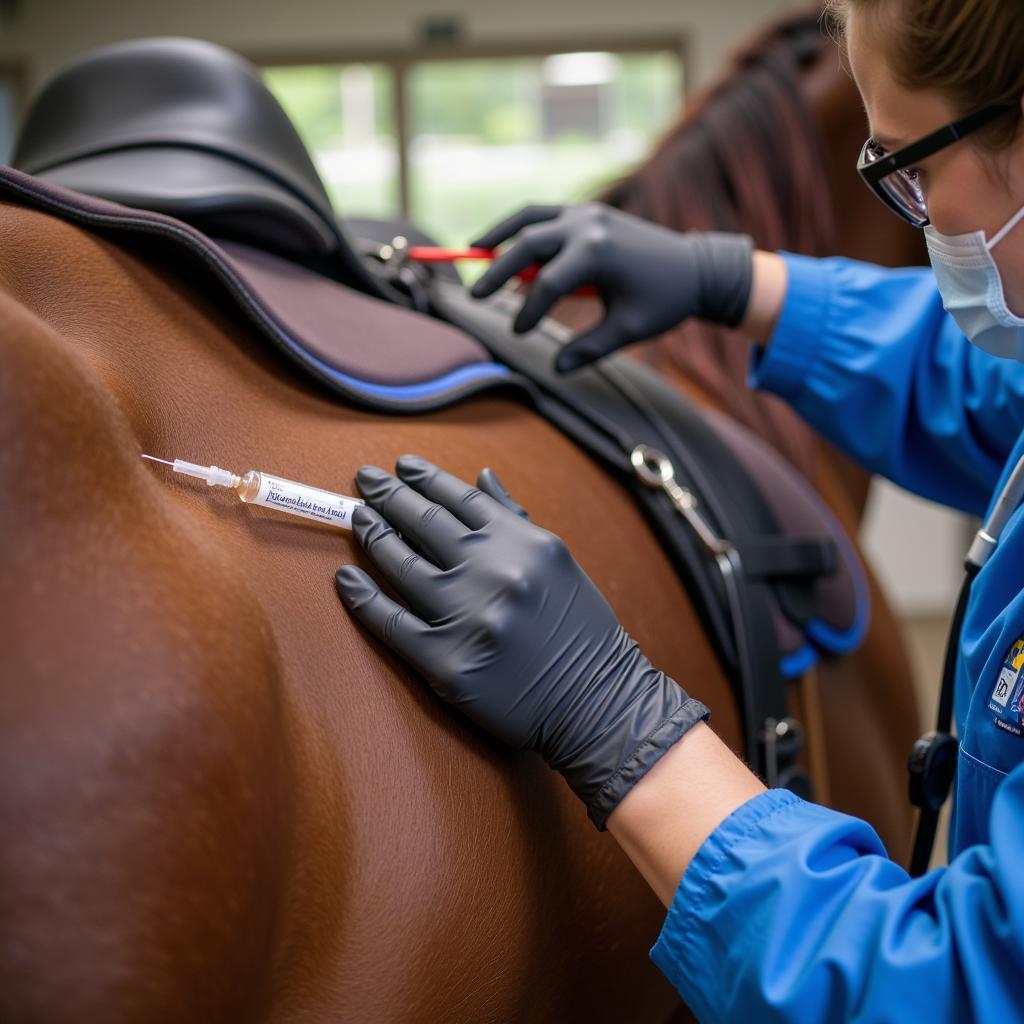Dormosedan injection, also known by its generic name detomidine hydrochloride, is a powerful sedative commonly used in equine veterinary practice. Understanding its uses, dosage, and potential side effects is crucial for any horse owner or caregiver. This guide provides a comprehensive overview of Dormosedan, empowering you with the knowledge to ensure your horse’s safety and well-being.
Understanding Dormosedan (Detomidine Hydrochloride)
Dormosedan is an alpha-2 adrenergic agonist that works by affecting the horse’s central nervous system. It induces a state of sedation and analgesia, making it valuable for a variety of veterinary procedures. The drug can be administered intravenously (IV) or intramuscularly (IM), with IV administration resulting in a faster onset of sedation. The effects of Dormosedan typically last for 1-2 hours, depending on the dosage and individual horse.
After the first paragraph of this introduction, we recommend consulting a veterinarian for specific guidance regarding Dormosedan usage. Proper dosage and administration are critical for the safety of your horse. You can also find more information regarding detomidine horse dose.
What is Dormosedan Used For?
Dormosedan is employed for a range of procedures, from minor examinations to more complex surgeries. Its sedative and analgesic properties make it ideal for:
- Pre-operative sedation for surgical procedures
- Facilitating diagnostic examinations like X-rays and ultrasounds
- Dental procedures
- Wound management
- Treatment of colic
- Transportation
Common Dosages and Administration
The appropriate dosage of Dormosedan varies based on the horse’s weight, the intended procedure, and the veterinarian’s assessment. It’s crucial to consult with a qualified veterinarian to determine the correct dosage for your horse. Overdosing can lead to serious complications, including respiratory depression and cardiovascular issues.
 Administering Dormosedan Injection to a Horse
Administering Dormosedan Injection to a Horse
Potential Side Effects of Dormosedan
While Dormosedan is generally safe when administered correctly, it’s essential to be aware of potential side effects. These can include:
- Slowed heart rate (bradycardia)
- Decreased respiratory rate
- Sweating
- Muscle tremors
- Ataxia (incoordination)
- Increased urination
Most side effects are mild and transient. However, if you observe any concerning symptoms, contact your veterinarian immediately.
Minimizing Risks and Side Effects
Proper administration and monitoring are crucial for minimizing the risks associated with Dormosedan. Ensure your veterinarian is experienced with the drug, and follow their instructions carefully. Closely observe your horse after administration for any adverse reactions.
 Horse Recovering from Dormosedan Sedation
Horse Recovering from Dormosedan Sedation
Dormosedan Injection: What to Expect
When your horse receives a Dormosedan injection, you can expect to see a gradual onset of sedation. The horse will become calmer and less responsive to external stimuli. Its head may lower, and its eyelids may droop. It’s important to keep the horse in a safe, quiet environment during this time to prevent injury.
Dr. Emily Carter, DVM, a leading equine veterinarian based in Kentucky, emphasizes, “Dormosedan is an invaluable tool for equine practitioners. However, it’s crucial to remember that every horse reacts differently. Careful monitoring and appropriate dosing are paramount for ensuring a positive outcome.”
Combining Dormosedan with Other Drugs
Dormosedan can be combined with other drugs, such as butorphanol or xylazine, to enhance its sedative and analgesic effects. These combinations are often used for more painful procedures or for horses that are difficult to sedate with Dormosedan alone.
Conclusion: Safe and Effective Sedation with Dormosedan
Dormosedan injection offers a safe and effective method for sedating horses for a variety of veterinary procedures. By understanding its uses, potential side effects, and the importance of proper administration, horse owners and caregivers can contribute to the well-being of their equine companions. Always consult your veterinarian for specific guidance regarding Dormosedan use and dosage.
FAQ
-
How long does Dormosedan take to work? Dormosedan typically takes effect within 15-30 minutes after administration.
-
Can I administer Dormosedan to my horse myself? No, Dormosedan should only be administered by a qualified veterinarian.
-
What are the signs of a Dormosedan overdose? Signs of an overdose can include severe bradycardia, respiratory distress, and collapse. Seek immediate veterinary attention if these occur.
-
Is Dormosedan safe for pregnant mares? Consult your veterinarian before using Dormosedan on a pregnant mare, as the drug may pose risks to the foal.
-
How long does the sedation last? The effects of Dormosedan typically last for 1-2 hours.
-
What should I do if my horse experiences adverse reactions? Contact your veterinarian immediately if your horse experiences any concerning side effects.
-
Can Dormosedan be used for pain relief? While Dormosedan has some analgesic properties, it’s primarily used for sedation. It may be combined with other pain medications for better pain management.
You might also be interested in our article on detomidine horse dose.
For further assistance, please contact us: Phone: 0772127271, Email: [email protected] or visit us at QGM2+WX2, Vị Trung, Vị Thuỷ, Hậu Giang, Việt Nam. Our customer service team is available 24/7.